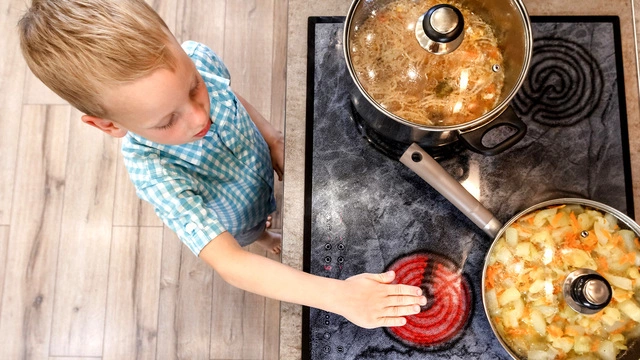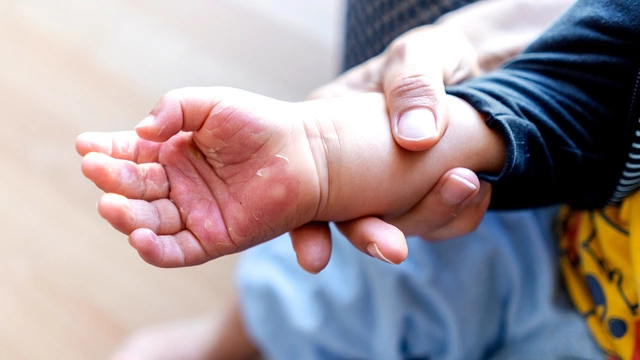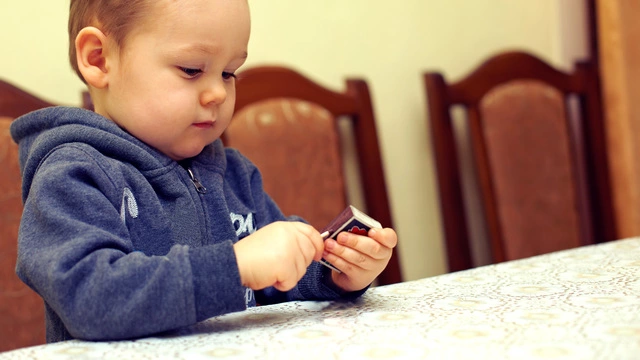In his blog “Notes from a pediatrician,” pediatrician Sergei Butriy talked about how to create the safest possible space at home and how to act, if the child does receive a burn.
 26479
26479
Many common household things, including hot water from a tap, a pot of soup on the stove, an iron that hasn’t cooled down, or a boiling kettle, can cause children’s burns. The skin of babies is very delicate, and where the parent is not at all hot, the child can really get burned.
If the baby does get burned, try to focus on providing first aid before comforting him. This is extremely important – the immediate reaction of an adult will speed up the healing of the burn, reduce its area and the severity of skin damage.
First aid for burns
1. Remove the child away from the source of the burn and eliminate the damaging factor. If your clothing is on fire, use a towel, thick blanket, or something else to extinguish the flame.
Cool the burned area. Do this as soon as possible by placing the affected part of your body under running cool (not ice) water for 10 to 20 minutes. Keep the water cool and the flow low. A strong jet can further damage the burned skin and increase pain.
2. Cooling will help reduce the depth of the burn and help the wound heal faster. Do not use ice or ice water for cooling because this may restrict blood flow to the affected tissues. You want to remove excess heat from the fabrics, not cause additional cold damage to the fabrics.
Cool only the affected area, not the child's entire body. For the torso, use a shower rather than a soak in the bath. If you put your child in a cold bath, he or she may become hypothermic within 20 minutes. Do not blow on the burn, because the wound may become infected.
3. While you cool the affected area, assess the severity of the situation. Call an ambulance if:
– the child’s burn covers more than 5% of his skin (that is, the area of more than five of the child’s palms; one child’s palm with fingers covers approximately 1% of his skin);
– a burn is caused by electric current or chemicals;
– a burn affects the face, neck, hands, feet or crotch;
– a burn affects the entire limb circle;
– the burn was received during a fire, the child inhaled smoke;
– the child’s symptoms or his general condition frighten you with their severity, you fear for the child’s life.
In other situations, contact your pediatrician or surgeon on an outpatient basis, in the next 24 hours.
 Photo: Sopotniccy/Depositphotos
Photo: Sopotniccy/Depositphotos
4. Remove any tight clothing near your child's burn before the affected body part begins to swell. If removing clothing increases the pain, carefully cut it with scissors. If part of the clothing is stuck to the wound, cut and remove those parts that are easy to remove, but do not tear off the piece of clothing stuck to the wound, give it to the doctor.
5. Keep the child's burned area elevated if possible to reduce swelling.
6. Apply a sterile bandage to the burn site. Try not to damage any bubbles if there are any. It is optimal to use hydrogel dressings, such as Hydrocoll, or ointment dressings, such as Branolind – they do not stick to the wound after it dries, and they are then easy to remove when dressing. Alternatively, you can use sterile cotton gauze, but do not use cotton wool, as the fibers may stick to the crust on the wound and remain in it.
DO NOT APPLY skin cream or spray (even with panthenol), honey, butter, sour cream;
DO NOT use raw potatoes, raw egg whites, etc. This will only retain heat and increase the depth and area of the burn, and can also introduce infection into the wound. Apply an appropriate burn cream only after consulting with your child's doctor.
7. After you have given your child first aid for a burn, you can relieve his pain with children's paracetamol or ibuprofen in an age-appropriate dosage.
If the burn area is 1-2%, if the skin is simply red and painful, there are no blisters or they are very small, if the burn site is not on the face, perineum and other dangerous places, such a burn can be cured without the participation of a doctor. However, in most cases, it is better to take the child to a specialist to receive advice on optimal care of the burn wound and prevention of complications.
Minor burns are dangerous for secondary infection and the risk of the formation of gross, disfiguring and/or constricting scars. Large and deep burns can lead to life-threatening complications.
If your child has third-degree burns, or less deep but extensive burns, he or she may need to be monitored in a hospital.
If your child has inhaled smoke, or received an electric shock, or is dehydrated, or is in pain shock, the doctor may keep the child under observation in the hospital for several days or longer.
Preventing burns
-
Do not leave hot drinks where a child can reach them (on the edge of the table), get rid of tablecloths. Do not drink a hot drink while holding or standing over your baby. Remember that a hot drink can burn your child even 15 minutes after you prepare it.
-
Be careful when cooking on the stove or using oven. Turn the handles of the pots towards the back of the stove so that the child cannot reach and pull them.
-
Place the kettle and toaster deeper, taking special care to hide the cords from them, The child can use the cord to pull the hot object towards himself.
-
Keep matches and lighters in a locked drawer or cabinet where children cannot reach them. If your gas stove does not have an ignition button, use a piezo lighter to turn on the burner – it is safer because there is no open flame.
 Photo: olesiabilkei/Depositphotos
Photo: olesiabilkei/Depositphotos
-
Install a fire extinguisher and fire blanket where the risk of fire is greatest, such as the kitchen. However, only attempt to put out a fire if it is small and contained. Otherwise, get everyone out of the house as soon as possible and dial 112.
-
Install a smoke alarm in every bedroom and near the kitchen.
-
Place candles or oil lamps out of the reach of children. Extinguish the flame when leaving the room. Never leave a child alone in a room with a lit candle or oil lamp. Also, do not leave animals alone with an open fire – your cat's fluffy tail can become a torch that sets the room on fire.
-
Always pour into the bathtub or basin first cold water, and only then hot. Do not put your child in water until you have checked the temperature with your elbow. Never leave a child alone in the bathroom.
-
Keep hair dryers, hair straighteners and curling irons unplugged and out of the child's reach. Be careful with any heaters.
Based on materials from the blog of pediatrician Sergei Butria “Notes of a pediatrician.”
